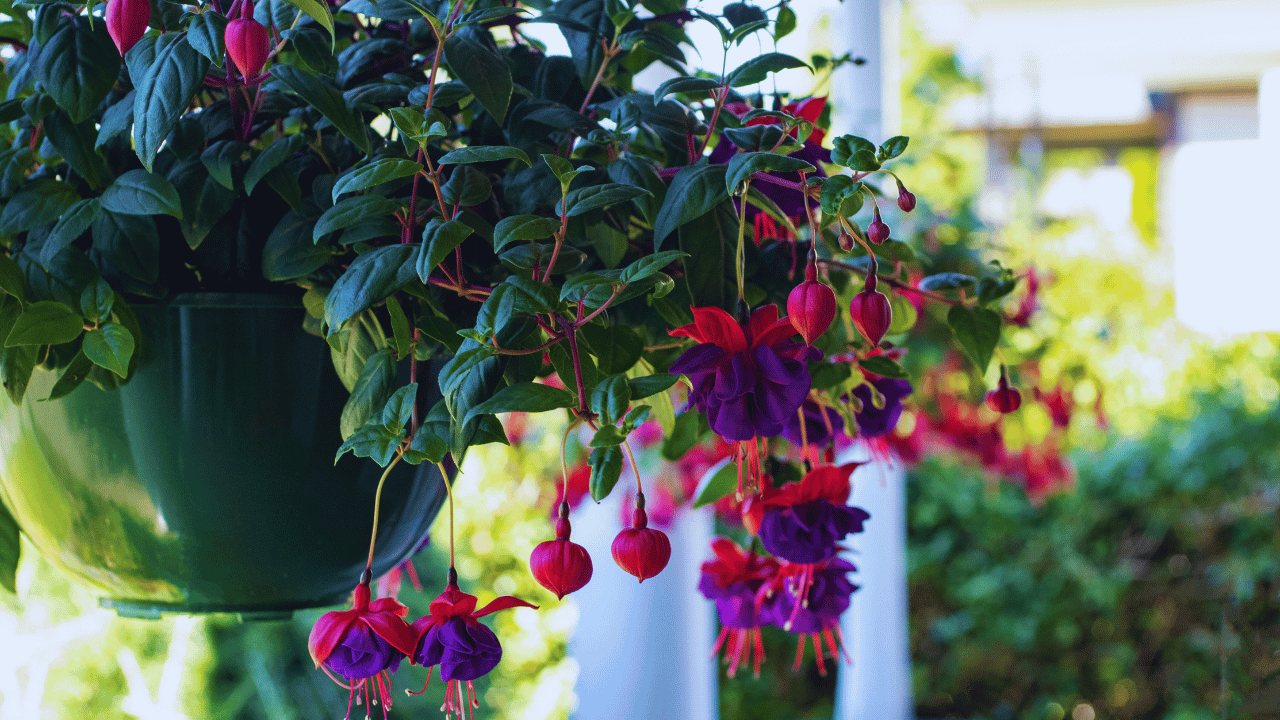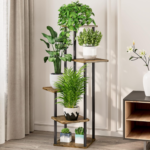The Fuchsia flower plant is a tropical and subtropical beauty known for its stunning two-tone blooms, which come in shades of pink, purple, red, and white. Native to Central and South America, Fuchsias are often grown as ornamental plants in hanging baskets, containers, or flower beds. With over 100 species and thousands of cultivars, this plant has captured the hearts of gardeners worldwide.
Fuchsias thrive in cooler temperatures and shaded environments, making them ideal for woodland gardens or north-facing balconies. Their delicate flowers not only enhance your garden’s aesthetic appeal but also attract pollinators like hummingbirds and bees. Their graceful form, fast growth, and prolific blooming make them a favorite among container gardeners and landscapers.
If you want to enjoy vibrant, cascading blossoms all summer long, growing Fuchsia might be the right choice. Let’s dive deeper into how to grow, care for, and maintain this stunning plant.
About Fuchsia Flower Plants

Fuchsia flower plants are ornamental treasures celebrated for their elegant, drooping blossoms that resemble tiny, twirling ballerinas. Native to Central and South America, New Zealand, and Tahiti, these plants belong to the Onagraceae family and include over 100 species and thousands of hybrids. Their eye-catching, two-toned flowers—often in vibrant shades of pink, purple, red, and white—make them popular in hanging baskets, window boxes, containers, and shaded garden beds.
Fuchsias are typically classified into two types: upright (bush) and trailing (hanging) varieties. The upright types grow as small shrubs and are perfect for pots and garden borders, while the trailing types are ideal for hanging baskets where their cascading blooms can shine. Most Fuchsia plants are grown as perennials in mild climates but are treated as annuals or overwintered indoors in colder regions.
Types of Fuchsia Flower Plants
Fuchsia plants come in a wide range of species, hybrids, and cultivars, offering a diverse selection to suit nearly any garden or container setting. These plants are typically categorized based on their growth habit—upright (bush) or trailing (hanging)—but their flower shapes and colors also vary widely, providing endless design possibilities.
1. Upright Fuchsias (Bush Type)
Upright varieties grow as small shrubs and are perfect for borders, containers, or as a focal point in the landscape. They produce a bushy structure with vertical stems and are often used in formal flower beds. Common examples include:
- Fuchsia ‘Beacon’ – known for its red and purple flowers.
- Fuchsia magellanica – a hardy perennial variety ideal for outdoor gardens.
2. Trailing Fuchsias
Trailing types are designed for hanging baskets, window boxes, and containers, where their arching stems and cascading blooms can really show off. Popular varieties include:
- Fuchsia ‘Swingtime’ – large double flowers with white and red petals.
- Fuchsia ‘Dark Eyes’ – a standout with deep purple and magenta blossoms.
3. Hardy Fuchsias
Some species like Fuchsia magellanica are more tolerant of cold and can be grown as perennials in USDA zones 6–9. These varieties tend to have smaller flowers but bloom consistently and resist light frost.
With so many cultivars available, gardeners can select Fuchsias that suit their specific climate, container size, or color preference, making them one of the most versatile flowering plants for shaded gardens and balconies.
Ideal Growing Conditions for Fuchsia Plants
Creating the right environment is essential for the healthy growth of Fuchsia plants. These plants thrive in bright, indirect light and prefer cool, moist climates. While they need plenty of light to bloom, direct sunlight, especially during midday, can scorch the leaves and cause flower drop. Ideally, Fuchsias should be placed where they receive morning sunlight and are protected from harsh afternoon rays.
Temperature plays a vital role. Fuchsias perform best when daytime temperatures range between 60°F and 75°F (15°C to 24°C), with nighttime temperatures not dropping below 45°F (7°C). Excessive heat can stress the plant, while frost can damage or kill it. Therefore, in regions with cold winters, it’s best to grow Fuchsias in containers that can be moved indoors during colder months.
Humidity and air circulation are also important. Fuchsias like a humid environment but should not be placed where airflow is restricted, as this can lead to fungal issues. A well-ventilated area with good air movement reduces the risk of powdery mildew and botrytis.
Soil Requirements and Potting Tips

Fuchsias prefer well-draining, nutrient-rich soil to support healthy root development and continuous flowering. A mix that retains moisture without becoming waterlogged is ideal. A high-quality potting mix containing peat moss, perlite, and compost works well for container-grown Fuchsias. Garden beds should be amended with organic matter to improve texture and fertility.
Soil pH should be slightly acidic to neutral, ideally in the range of 6.0 to 7.0. You can test the pH using a home soil kit and make adjustments as necessary. Adding compost or well-rotted manure can help regulate the pH and enrich the soil with essential nutrients.
When potting Fuchsias, select a container with adequate drainage holes. Terracotta pots are a great choice as they allow air to circulate around the roots and help prevent overwatering. Choose a pot that is slightly larger than the root ball, allowing space for growth.
Repotting should be done every one to two years or when the plant becomes root-bound. Gently loosen the roots, remove old soil, and refresh with a new mix. This practice prevents nutrient depletion and promotes healthier growth.
Good soil is the foundation of a thriving Fuchsia plant. Invest time in preparing the right mix, and your plant will reward you with lush foliage and brilliant blooms.
Watering and Fertilizing Your Fuchsia
Proper watering is crucial for Fuchsia plants. They prefer evenly moist soil—neither too dry nor too soggy. Overwatering can lead to root rot, while underwatering may cause flower drop and leaf wilting. During the growing season (spring to fall), check the soil frequently and water when the top inch feels dry to the touch.
Container plants may need daily watering during hot spells, whereas garden-planted Fuchsias may require less frequent watering depending on rainfall and soil conditions. Always water early in the day to reduce the risk of fungal diseases and allow the foliage to dry before nightfall.
Fuchsias are heavy feeders and benefit from regular fertilization. Use a balanced, water-soluble fertilizer (like 10-10-10 or 20-20-20) every two weeks during the active growing period. Alternatively, you can use a slow-release fertilizer at the start of the season. Avoid high-nitrogen fertilizers, as they may promote excessive foliage at the expense of flowers.
To encourage blooming, switch to a high-phosphorus formula (like 10-30-20) during peak flowering times. Also, consider adding organic options like fish emulsion or seaweed extract to boost plant health naturally.
A consistent watering and feeding schedule helps Fuchsias produce lush blooms and stay healthy throughout the season.
Pruning and Maintenance Tips
Pruning is essential for keeping your Fuchsia plant full, bushy, and blooming. Regular pinching of young shoots encourages branching and more flowers. Start by pinching the tips when the plant is about 6 inches tall and continue pinching every few weeks throughout the growing season.
Deadheading—removing spent blooms—prevents seed formation and promotes new flower growth. Use clean, sharp scissors or pruners to cut just above a leaf node. Also, remove yellowing leaves, weak stems, or any parts affected by pests or diseases to keep the plant tidy and healthy.
At the end of the growing season, especially in colder zones, cut back the plant by one-third to half its size before overwintering. This not only conserves energy but also prepares it for new growth in spring.
If grown in containers, inspect roots occasionally. Root-bound plants may show reduced vigor and should be repotted. Cleaning the pot and refreshing the soil during repotting also helps prevent disease buildup.
Consistent pruning, deadheading, and basic upkeep are key to maintaining a compact, floriferous Fuchsia. These simple steps result in a stunning plant that remains a garden favorite all season long.
Common Pests and Diseases to Watch Out For

Fuchsia plants are generally healthy but can fall prey to pests and diseases, especially if grown in poor conditions. The most common pests include aphids, whiteflies, spider mites, and mealybugs. These insects feed on the plant’s sap, causing leaf curling, discoloration, and stunted growth.
Use insecticidal soap or neem oil to control infestations naturally. For severe issues, consider a stronger horticultural oil or appropriate pesticide, always following label instructions. Also, introducing beneficial insects like ladybugs can help control aphid populations.
Fuchsias are also susceptible to fungal diseases like botrytis (gray mold), rust, and powdery mildew. These issues typically arise in humid or poorly ventilated areas. Symptoms include discolored spots, white powdery coatings, and leaf drop.
To prevent disease, water the soil—not the leaves—and ensure proper spacing for air circulation. Avoid overhead watering and clean fallen debris regularly. If infection occurs, remove affected parts and apply a fungicide.
Root rot is another concern, often caused by overwatering or poor drainage. Yellowing leaves and wilting can indicate this problem. Ensure your soil drains well and adjust watering habits accordingly.
With proper care and prompt attention to signs of trouble, you can keep your Fuchsia plant healthy and thriving.
Propagating Fuchsias: How to Grow More from Cuttings
Propagating Fuchsias is an exciting and cost-effective way to grow new plants from a parent specimen. The most common method is through stem cuttings, typically taken during spring or early summer when the plant is actively growing.
Start by selecting healthy, non-flowering stems about 4–6 inches long. Cut just below a leaf node using sterilized scissors. Remove the lower leaves, leaving only the top two sets. Dip the cut end in rooting hormone to improve success rates, though this is optional.
Plant the cutting in a small pot filled with a moist mix of perlite and peat or a seed-starting medium. Cover the pot with a plastic bag or humidity dome to maintain moisture, and place it in a bright, indirect light location. Within 2–4 weeks, roots should develop.
Once rooted, transplant the new Fuchsia into a larger pot with regular potting soil. Keep it well-watered and feed lightly until established.
You can also propagate Fuchsias by layering or from seed, but stem cuttings are the fastest and easiest method. With a bit of patience, you can fill your garden with dozens of vibrant Fuchsia plants—all for free.
Final Thoughts:
Fuchsia plants are more than just a pretty face—they offer gardeners a low-maintenance yet high-impact display of elegance and charm. Their versatility allows them to thrive in containers, baskets, beds, and borders, making them suitable for all garden types. The vivid, pendant-shaped blooms are not only visually stunning but also attract pollinators, enhancing your garden’s ecosystem.
Whether you’re seeking color, texture, or an eye-catching focal point, Fuchsias deliver. With proper care, they bloom profusely from spring through fall, providing months of enjoyment. Plus, their ability to be propagated easily means you can expand your garden without added cost.
Frequently Asked Questions About Fuchsia Flower Plants
1. Can Fuchsia plants survive indoors?
Yes, Fuchsia plants can survive indoors, especially during the winter months when outdoor temperatures drop. They require a bright location with indirect sunlight, such as a north- or east-facing window. Proper airflow and humidity are essential, as indoor air tends to be dry. Mist the plant occasionally and keep it away from heat vents or cold drafts. Also, reduce watering and fertilizing during the plant’s dormant winter phase.
2. How long do Fuchsia plants bloom?
Fuchsia plants have an extended blooming season that can last from early spring through late fall if conditions are ideal. With regular feeding, proper pruning, and deadheading, you can encourage repeat blooming. In mild climates, some evergreen Fuchsia varieties may flower almost year-round.
3. Why are the leaves on my Fuchsia plant turning yellow?
Yellowing leaves can be a sign of several issues, such as overwatering, poor drainage, lack of nutrients, or pest infestations. First, check the soil moisture and drainage conditions. Ensure the roots aren’t sitting in water. Also, evaluate the fertilization schedule—if your plant hasn’t been fed in a while, a dose of balanced fertilizer might help.
4. Should I bring my Fuchsia plant indoors during winter?
Yes, if you live in a region with frost or cold winters, it’s best to bring your Fuchsia indoors. Cut it back by about one-third, check for pests, and place it in a cool, well-lit area. Water sparingly until spring, when new growth begins. You can then gradually reintroduce the plant outdoors after the last frost.
5. Do Fuchsias need to be staked or supported?
While trailing varieties in hanging baskets don’t need support, upright bushy Fuchsia varieties may benefit from staking, especially when heavy with blooms. Use bamboo sticks or small garden stakes to keep the branches upright and prevent breakage.







